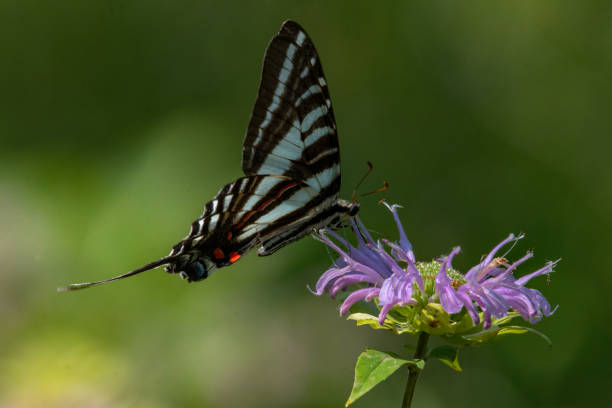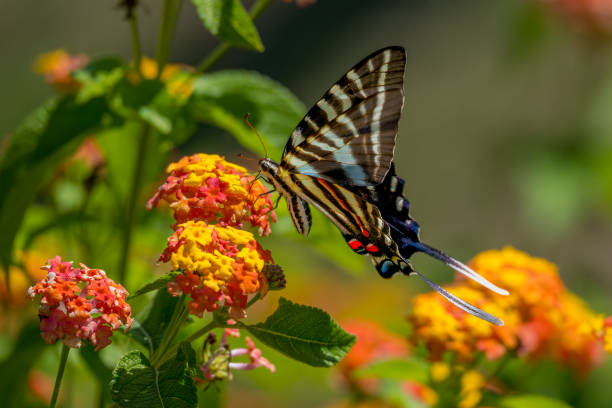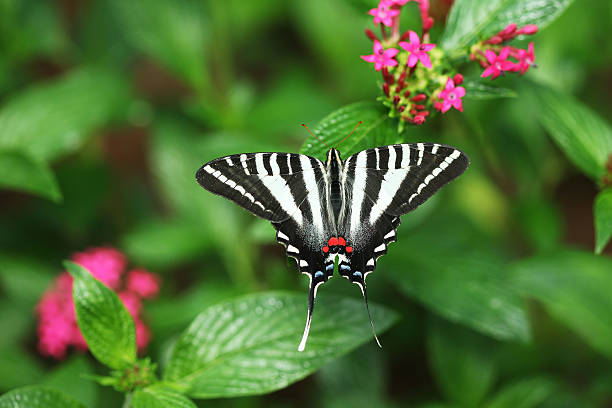Table of Contents
Scientific Classification
| Kingdom | Animalia |
| Phylum | Arthropoda |
| Class | Insecta |
| Order | Lepidoptera |
| Family | Papilionidae |
| Genus | Eurytides |
| Species | marcellus |
| Scientific Name | Eurytides marcellus |
Description
The Zebra Swallowtail Butterfly is a stunning insect known for its distinctive black and white striped wings, reminiscent of a zebra’s patterns. Its hindwings feature long, elegant tails, adding to the butterfly’s unique and graceful appearance. The wingspan usually measures between 2.5 to 4 inches. During the summer, the butterflies may display a bluish-green tint on their wings, while in spring, they appear more black and white. The elongated tails are a key characteristic that helps set them apart from other swallowtail species.
Distribution
Zebra Swallowtail Butterflies primarily inhabit North America. They are commonly seen from the southeastern United States extending into parts of the Midwest. States such as Florida, Georgia, and South Carolina are frequent locations for these butterflies. They can also be spotted as far north as Illinois and Pennsylvania. Their distribution is closely linked to the availability of their main host plant, the pawpaw tree.
Habitat
These butterflies prefer warm and humid environments. They flourish in forests, woodlands, along riverbanks, and in meadows where pawpaw trees (Asimina species) are found.

Diet
The Zebra Swallowtail Butterfly exhibits unique dietary preferences throughout its life stages:
Caterpillars exclusively consume pawpaw leaves, which contain toxic compounds that deter many predators from eating them.
In contrast, adult butterflies primarily feed on nectar from flowers such as redbud, verbena, lantana, and milkweed. They also engage in a behavior known as puddling, where they sip moisture and minerals from damp soil.
Behavior
Zebra Swallowtails are diurnal butterflies known for their elegant, fluttering flight. They are powerful fliers, often gliding between their wing beats, which gives their movement a unique quality. Males are known to be territorial, regularly patrolling their breeding grounds in search of females. When threatened, they can execute impressive aerial maneuvers to evade predators.
Lifespan
Zebra Swallowtails, similar to many butterfly species, have relatively brief lifespans. As adults, they typically live for around a month. Their entire lifecycle, from egg to mature butterfly, spans approximately six to eight weeks. In warmer regions, the climate supports several generations each year, allowing them to reproduce during the spring and summer months.
Reproduction and Lifecycle
The reproductive cycle of the Zebra Swallowtail undergoes a complete metamorphosis:
Eggs: Female butterflies lay small, round eggs on the underside of pawpaw leaves.
Caterpillar Stage: After a few days, the larvae hatch and begin to feed eagerly on the leaves. They are green with yellow stripes, which helps them camouflage in their environment.
Pupa (Chrysalis): The caterpillar forms a chrysalis, which can be either brown or green, allowing it to blend in with tree bark or foliage.
Adult Butterfly: The adult butterfly emerges in two to three weeks, ready to continue the cycle.
The adult butterfly appears in two to three weeks, ready to keep the cycle going.

Predators
Zebra Swallowtail Butterflies, known for their beautiful appearance, encounter various dangers in their natural habitat. Their main predators consist of:
Birds like flycatchers and blue jays
Spiders that ensnare them in their webs
Wasps and ants that target their eggs and caterpillars. Interestingly, both caterpillars and adult butterflies feed on pawpaw leaves, which provide them with toxic compounds, making them less attractive to many predators.
Adaptations
The Zebra Swallowtail Butterfly has evolved various adaptations for survival:
Mimicry and Camouflage: Their black and white striped wings allow them to blend into the sunlight, making it more challenging for predators to spot them.
Toxicity: The caterpillars gather chemicals from pawpaw leaves, which serve as a deterrent to potential predators.
Quick Flight Patterns: Their unpredictable flight movements make them hard to catch.
Seasonal Changes: Their colors change slightly from spring to summer, helping them adapt to different environments.
Conservation Status
The Zebra Swallowtail Butterfly is currently not classified as endangered. However, threats such as habitat destruction and deforestation are impacting their numbers. Urban development and climate change can significantly disrupt the breeding and survival of pawpaw trees, which are crucial for the butterfly’s lifecycle. Conservation efforts are aimed at safeguarding native forests and include initiatives to plant more pawpaw trees.
This butterfly is a remarkable species that plays a vital role in the ecosystem, serving both as a pollinator and as a food source for other animals. The pawpaw tree, with its striking patterns and unique adaptations, exemplifies the delicate balance of nature. By protecting its habitat, we can ensure that future generations will have the opportunity to appreciate the beauty of this butterfly in the wild.



